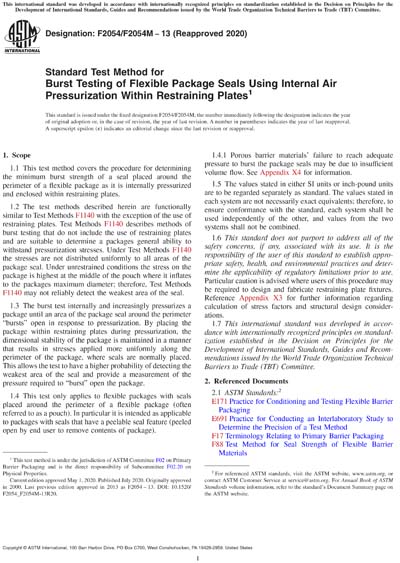Most recent
ASTM F2054/F2054M-13(2020)
Standard Test Method for Burst Testing of Flexible Package Seals Using Internal Air Pressurization Within Restraining Plates
1.1 This test method covers the procedure for determining the minimum burst strength of a seal placed around the perimeter of a flexible package as it is internally pressurized and enclosed within restraining plates.
1.2 The test methods described herein are functionally similar to Test Methods F1140 with the exception of the use of restraining plates. Test Methods F1140 describes methods of burst testing that do not include the use of restraining plates and are suitable to determine a packages general ability to withstand pressurization stresses. Under Test Methods F1140 the stresses are not distributed uniformly to all areas of the package seal. Under unrestrained conditions the stress on the package is highest at the middle of the pouch where it inflates to the packages maximum diameter; therefore, Test Methods F1140 may not reliably detect the weakest area of the seal.
1.3 The burst test internally and increasingly pressurizes a package until an area of the package seal around the perimeter “bursts” open in response to pressurization. By placing the package within restraining plates during pressurization, the dimensional stability of the package is maintained in a manner that results in stresses applied more uniformly along the perimeter of the package, where seals are normally placed. This allows the test to have a higher probability of detecting the weakest area of the seal and provide a measurement of the pressure required to “burst” open the package.
1.4 This test only applies to flexible packages with seals placed around the perimeter of a flexible package (often referred to as a pouch). In particular it is intended as applicable to packages with seals that have a peelable seal feature (peeled open by end user to remove contents of package).
1.4.1 Porous barrier materials' failure to reach adequate pressure to burst the package seals may be due to insufficient volume flow. See Appendix X4 for information.
1.5 The values stated in either SI units or inch-pound units are to be regarded separately as standard. The values stated in each system are not necessarily exact equivalents; therefore, to ensure conformance with the standard, each system shall be used independently of the other, and values from the two systems shall not be combined.
1.6 This standard does not purport to address all of the safety concerns, if any, associated with its use. It is the responsibility of the user of this standard to establish appropriate safety, health, and environmental practices and determine the applicability of regulatory limitations prior to use. Particular caution is advised where users of this procedure may be required to design and fabricate restraining plate fixtures. Reference Appendix X3 for further information regarding calculation of stress factors and structural design considerations.
1.7 This international standard was developed in accordance with internationally recognized principles on standardization established in the Decision on Principles for the Development of International Standards, Guides and Recommendations issued by the World Trade Organization Technical Barriers to Trade (TBT) Committee.
ASTM International [astm]

